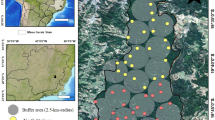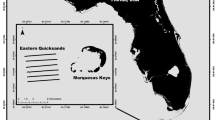Abstract
The aim of this survey was to test a standardised method to follow the demographic evolution of a dense aggregative ‘forest’ population of the temperate gorgonian Eunicella verrucosa (Octocorallia, Gorgoniidae) using in situ photographic recordings. Distribution, density, growth and demographic evolution of the colonies was compared along two parallel transects. Computer treatment allowed the estimation of the total branch fan surface area, and the individual growth of tagged colonies was determined by measuring the increase in this surface area, using consecutive photographs taken at two-year intervals. To integrate the potential bias of branch overlapping, we proposed a correction factor between the in situ photographic surface area and the surface area of the gorgonian calculated from ex situ photographic surface area with all branches deployed. The surface-frequency distribution of colonies was converted to estimated-age-frequency distribution using an estimated growth curve based on the net growth rate. The technique used revealed significant differences in population structure and the dynamics of gorgonian colonies, as the two transects appeared to be influenced by different environmental conditions. The recruitment also seemed to vary according to year and transect, resulting in different densities. Our work showed clear results in characterising the variations of gorgonian demographic evolution at a small spatial scale; thus, it is assumed that this method could be a sustainable tool for coastal environmental managers.











Similar content being viewed by others
References
Borja A, Bricker SB, Dauer DM, Demetriades NT, Ferreira JG, Forbes AT, Hutchings P, Jia X, Kenchington R, Marques JC, Zhu C (2008) Overview of integrative tools and methods in assessing ecological integrity in estuarine and coastal systems worldwide. Mar Poll Bull 56:1519–1537
Buhl-Mortensen L, Mortensen PB (2005) Cold-water corals and ecosystems. Dans: Erlangen earth conference series. Springer, Berlin, pp 849–879
Chang WL, Chi KJ, Fan TY, Dai CF (2007) Skeletal modification in response to flow during growth in colonies of the sea whip, Junceella fragilis. J Exp Mar Bio Ecol 347:97–108
Coma R, Ribes M, Zabala M, Gili JM (1995a) Reproduction and cycle of gonadal development in the Mediterranean gorgonian Paramuricea-Clavata. Mar Ecol Prog Ser 117:173–183
Coma R, Zabala M, Gili JM (1995b) Sexual reproductive effort in the Mediterranean gorgonian Paramuricea clavata. Mar Ecol Prog Ser 117:185–192
Coma R, Ribes M, Zabala M, Gili JM (1998) Growth in a modular colonial marine invertebrate. Estuar Coast Shelf Sci 47:459–470
Coma R, Pola E, Ribes M, Zabala M (2004) Long-term assessment of temperate octocoral mortality patterns, protected vs. unprotected areas. Ecol Appl 14:1466–1478
Connor D, Allen J, Golding N, Howell K, Lieberknecht L, Northen K, Reker J (2004) The marine habitat classification for Britain and Ireland version 04.05 JNCC, Peterborough, p 127
EUNIS (2009) European Environment Agency-European Nature Information System. http://eunis.eea.europa.eu/species/196552/habitats. Accessed 1 Sep 2011
Goffredo S, Lasker HR (2006) Modular growth of a gorgonian coral can generate predictable patterns of colony growth. J Exp Mar Bio Ecol 336:221–229
Gori A, Rossi S, Berganzo E, Pretus JL, Dale MRT, Gili JM (2010) Spatial distribution patterns of the gorgonians Eunicella singularis, Paramuricea clavata, and Leptogorgia sarmentosa (Cape of Creus, Northwestern Mediterranean Sea). Mar Biol 158:143–158
Gotelli NJ (1988) Determinants of recruitment, juvenile growth, and spatial distribution of a shallow-water gorgonian. Ecology 69:157–166
Grigg RW (1974) Growth rings: annual periodicity in two gorgonians corals. Ecology 55:876–881
Hayward P, Ryland J (1995) Handbook of the marine fauna of North-West Europe. Oxford University Press, Oxford
Hiscock K (2007) Eunicella verrucosa. Pink sea fan. Marine life information network: biology and sensitivity key information sub-programme, Plymouth. Plymouth: Marine Biological Association of the United Kingdom. http://www.marlin.ac.uk/reproduction.php?speciesID=3317. Accessed 1 Sep 2011
Jones CG, Lawton JH, Shachak M (1994) Organisms as ecosystem engineers. Oikos 69:373–386
Kim K, Lasker HR (1998) Allometry of resource capture in colonial cnidarians and constraints on modular growth. Funct Ecol 12:646–654
Kinzie I, Robert A (1973) The zonation of West Indian gorgonians. Bull Mar Sci 23:93–155
Kirk N, Andras J, Harvell C, Santos S, Coffroth M (2009) Population structure of Symbiodinium sp. associated with the common sea fan, Gorgonia ventalina, in the Florida Keys across distance, depth, and time. Mar Biol 156:1609–1623
Lasker HR, Boller ML, Castanaro J, Sanchez JA (2003) Determinate growth and modularity in a gorgonian octocoral. Biol Bull 205:319–330
Linares C, Doak DF, Coma R, Diaz D, Zabala M (2007) Life history and viability of a long-lived marine invertebrate: the octocoral Paramuricea clavata. Ecology 88:918–928
Linares C, Coma R, Garrabou J, Diaz D, Zabala M (2008a) Size distribution, density and disturbance in two Mediterranean gorgonians: Paramuricea clavata and Eunicella singularis. J Appl Ecol 45:688–699
Linares C, Coma R, Zabala M (2008b) Restoration of threatened red gorgonian populations: an experimental and modelling approach. Biol Conserv 141:427–437
Lloret J, Zaragoza N, Caballero D, Riera V (2008) Impacts of recreational boating on the marine environment of Cap de Creus (Mediterranean Sea). Ocean Coast Manag 51:749–754
Martin D, Núñez J, Riera R, Gil J (2002) On the associations between Haplosyllis (Polychaeta, Syllidae) and gorgonians (Cnidaria, Octocorallaria), with the description of a new species. Biol J Linn Soc 77:455–477
Matsumoto AK (2003) Heterogeneous and compensatory growth in Melithaea flabellifera (Octocorallia: Melithaeidae) in Japan. Hydrobiologia 530(531):389–397
Metaxas A, Davis J (2005) Megafauna associated with assemblages of deep-water gorgonian corals in Northeast channel, off Nova Scotia, Canada. J Mar Biol Assoc UK 85:1381–1390
Mistri M, Ceccherelli V (1994) Growth and secondary production of the Mediterranean gorgonian Paramuricea clavata. Mar Ecol Prog Ser 103:291–296
Morisita M (1962) Iδ-index, a measure of dispersion of individuals. Res Popul Ecol 4:1–7
Mortensen P, Buhl-Mortensen L (2004) Distribution of deep-water gorgonian corals in relation to benthic habitat features in the Northeast Channel (Atlantic Canada). Mar Biol 144:1223–1238
Munro L, Munro C (2003) East Tennants Reef Seafan Project Interim Report, September 2003. A report to English Nature RR Report 9/2003 ETR 08
Quinn GP, Keough MJ (2002) Experimental design and data analysis for biologists. Cambridge University Press, Cambridge
Ribes M, Coma R, Rossi S, Micheli M (2007) Cycle of gonadal development in Eunicella singularis (Cnidaria: Octocorallia): trends in sexual reproduction in gorgonians. Inv Biol 126:307–317
Rinkevich B (2005) What do we know about Eilat (Red Sea) reef degradation? A critical examination of the published literature. J Exp Mar Bio Ecol 327:183–200
Sanchez JA, Lasker HR, Nepomuceno EG, Sanchez JD, Woldenberg MJ (2004) Branching and self-organization in marine modular colonial organisms: A model. Am Nat 163:24–39
Skoufas G (2006) Comparative biometry of Eunicella singularis (Gorgonian) sclerites in East Mediterranean Sea (North Aegean Sea, Greece). Mar Biol 149:1365–1370
Skoufas G, Poulicek M, Chintiroglou CC (2000) Growth variation of Eunicella singularis (Esper, 1794) (Gorgonacea, Anthozoa). Belg J Zool 130(Suppl):125–128
Stone R (2006) Coral habitat in the Aleutian Islands of Alaska: depth distribution, fine-scale species associations, and fisheries interactions. Coral Reefs 25:229–238
Toledo-Hernández C, Bones-González A, Ortiz-Vázquez O, Sabat A, Bayman P (2007) Fungi in the sea fan Gorgonia ventalina: diversity and sampling strategies. Coral Reefs 26:725–730
Velimirov B (1973) Orientation in the sea fan Eunicella cavolinii related to water movement. Helgoländer wiss. Meeresunters 24:163–173
Velimirov B (1975) Wachstum und Altersbestimmung des Gorgonie Eunicella cavolinii. Oecologia 19:259–272
Velimirov B (1976) Variations in growth forms of Eunicella cavolinii Koch (Octocorallai) related to intensity of water movement. J Exp Mar Biol Ecol 21:109–117
Weinbauer M, Velimirov B (1995) Morphological variations in the Mediterranean-sea fan Eunicella cavolinii (Coelenterata, Gorgonacea) in relation to exposure, colony size and colony region. Bull Mar Sci 56:283–295
Weinbauer M, Velimirov B (1996a) Population dynamics and overgrowth of the sea fan Eunicella cavolinii (Coelenterata: Octocorallia). Estuar Coast Shelf Sci 42:583–595
Weinbauer M, Velimirov B (1996b) Relative Habitat Suitability and Stability of the Mediterranean Gorgonian Coral Eunicella cavolinii (Coelenterata: Octocorallia). Bull Mar Sci 58:786–791
Weinberg S, Weinberg F (1979) The life cycle of a gorgonian: Eunicella singularis (Esper, 1794). Bijdragen Tot De Dierkunde 48:127–140
West J, Harvell C, Walls A (1993) Morphological plasticity in a gorgonian coral (Briareum asbestinum) over a depth cline. Mar Ecol Prog Ser 94:61–69
Yoshioka P (1996) Variable recruitment and its effects on the population and community structure of shallow-water gorgonians. Bull Mar Sci 59:433–443
Yoshioka P, Yoshioka B (1991) A comparison of the survivorship and growth of shallow-water gorgonian species of Puerto Rico. Mar Ecol Prog Ser 69:253–260
Zar JH (1996) Biostatistical analysis, 2nd edn. Prentice Hall, New Jersey
Acknowledgments
This study was supported by the SIAGM (Syndicat Intercommunal d’Aménagement du Golfe du Morbihan). We thank all the members of the association OXEA (scientists and naturalist divers), especially Anthony Doré and Michel Robert for their assistance during sampling activities, and Nicolas Larché for his help in studying the colony growth. We are indebted to Boris Leroy for some constructive criticisms on the manuscript. The authors would also like to thank Amelia Curd and Aldyth Nys, two native English speakers, for post-editing the English syntax.
Author information
Authors and Affiliations
Corresponding author
Additional information
Communicated by P. Kraufvelin.
Rights and permissions
About this article
Cite this article
Coz, R., Ouisse, V., Artero, C. et al. Development of a new standardised method for sustainable monitoring of the vulnerable pink sea fan Eunicella verrucosa . Mar Biol 159, 1375–1388 (2012). https://doi.org/10.1007/s00227-012-1908-7
Received:
Accepted:
Published:
Issue Date:
DOI: https://doi.org/10.1007/s00227-012-1908-7




